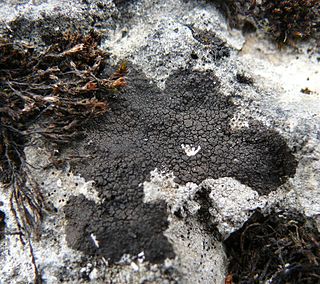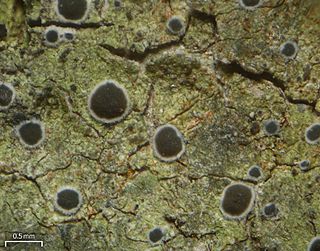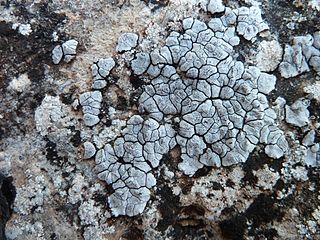
The Verrucariaceae are a family of mostly lichenised fungi in the order Verrucariales. The lichen-forming species, which comprise the vast majority of the family, have a wide variety of thallus forms, and include crustose (crust-like), foliose (bushy), and squamulose (scaly) representatives. Several characteristics of the spore-bearing structures, the ascomata, define the family, including their perithecioid form–more or less spherical or flask-shaped, with a single opening and otherwise completely enclosed by a wall. Squamulose members of the Verrucariaceae with simple ascospores, and without algae in the spore-bearing region are known as catapyrenioid lichens; there are more than 80 of these species. The family has several dozen lichenicolous (lichen-dwelling) examples, and a few genera that contain solely lichenicolous members. An unusually diverse variety of photobiont partners have been recorded, mostly green algae, but also brown algae and yellow-green algae.

Byssoloma is a genus of leaf-dwelling lichens in the family Pilocarpaceae.

Endocarpon is a genus of saxicolous (rock-dwelling), crustose lichens in the family Verrucariaceae. The genus was circumscribed by German bryologist Johann Hedwig in 1789.

Dermatocarpon is a genus of lichens in the family Verrucariaceae.
Clavascidium is a genus of lichens in the family Verrucariaceae. The genus was circumscribed in 1996 by Austrian lichenologist Othmar Breuss. Because the type species of the genus, Clavascidium umbrinum, has been shown using molecular phylogenetics to belong to genus Placidium, Cécile Gueidan and colleagues proposed to unite Clavascidium with Placidium in a 2009 publication. Despite this, the genus has been retained in recent publications of fungal classification.

Catapyrenium is a genus of lichens in the family Verrucariaceae. The genus was circumscribed by German botanist Julius von Flotow in 1850.

Placidium is a genus of crustose to squamulose to almost foliose lichens. The genus is in the family Verrucariaceae. Most members grow on soil, but some grow on rock (saxicolous). The fruiting bodies are perithecia, flask-like structures immersed in the lichen body (thallus) with only the top opening visible, dotting the thallus. Lichen spot tests are all negative. Members of the genus lack rhizines, but otherwise resemble members of the genus Clavascidium.

Placidiopsis is a genus of lichens in the family Verrucariaceae. The genus was circumscribed by Italian naturalist Francesco Beltramini de Casati in 1858, with Placidiopsis grappae assigned as the type species.
Neocatapyrenium is a genus of squamulose lichens in the family Verrucariaceae. It has five species. The genus was circumscribed by Hiroshi Harada in 1993, with Neocatapyrenium cladonioideum assigned as the type species.
Involucropyrenium is a genus of lichens in the family Verrucariaceae. It has nine species. The genus was circumscribed by Austrian lichenologist Othmar Breuss in 1996, with Involucropyrenium waltheri assigned as the type species.

Heteroplacidium is a genus of lichen-forming fungi in the family Verrucariaceae. The genus was circumscribed by Austrian lichenologist Othmar Breuss in 1996 with Heteroplacidium imbricatum assigned as the type species. It was proposed as a segregate of Catapyrenium. Other morphologically similar genera are Neocatapyrenium, Placidium, and Scleropyrenium, although molecular phylogenetic analyses indicate that they are independent monophyletic lineages within the Verrucariaceae.

Lobaria anthraspis is a species of foliose lichen in the subfamily Lobarioidiae of the family Peltigeraceae. It was originally named Sticta anthraspis by pioneer lichenologist Erik Acharius in 1803. In 1939, Swedish botanist Adolf Hugo Magnusson proposed a transfer to genus Pseudocyphellaria, and it was considered a member of that genus for several decades, until the advent of modern molecular phylogenetics led to refinements and reorganisation of family Peltigeraceae. Toby Spribille and Bruce McCune transferred it to Lobaria in 2014.

Dermatocarpon luridum is a species of lichen belonging to the family Verrucariaceae.
Neocatapyrenium disparatum is a species of squamulose lichen in the family Verrucariaceae. Found in the United States, the lichen was described as a new species in 2005 by Othmar Breuss. It is the only member of genus Neocatapyrenium that occurs outside of Eurasia. The type specimen was collected by Clifford Wetmore in a rocky valley in Big Bend National Park, Texas, at an elevation of 6,300 ft (1,900 m); here the lichen was discovered growing on moss over soil. It is only known to occur at the type locality. The specific epithet disparatum, meaning "separated", alludes to its similarity with and separation from the lookalike species Neocatapyrenium cladonioideum.
Eugeniella palleola is a species of corticolous (bark-dwelling) in the family Pilocarpaceae. Found in Nicauragua, it was formally described as a new species in 2015 by lichenologists Othmar Breuss and Robert Lücking. The type specimen was collected by Breuss in a montane rainforest on the Mombacho volcano at an altitude of 1,100 m (3,600 ft); here it was found growing on the smooth bark of small stems. The specific epithet palleola, meaning "rather pale", refers to the shade of the apothecial discs, which are lighter than other species of Eugeniella. Secondary chemicals that occur in the lichen include atranorin, stictic acid, and minor amounts of norstictic acid.

Placocarpus schaereri is a species of saxicolous (rock-dwelling), areolate, and crustose lichen in the family Verrucariaceae. Found in Europe, it is the type species of genus Placocarpus. The lichen was first described scientifically in 1831 by Elias Magnus Fries, who called it Parmelia schaereri. The species epithet honours Swiss pastor and lichenologist Ludwig Schaerer. Othmar Breuss transferred it to the newly reinstated genus Placocarpus in 1985.

Catapyrenium boccanum is a species of squamulose (scaley), rock-dwelling lichen in the family Verrucariaceae. It grows on mortar or on calcareous rock. Its squamules are up to 4 mm wide, pale to dark brown with black margins and a black underside. Ascospores measure 11–15 by 5–8 μm. Because of its combination of squamulose thallus, simple ascospores, and lack of algae in the hymenium, this species is a "catapyrenioid" lichen, of which more than 80 exist in the Verrucariaceae.
Dermatocarpon meiophyllizum is a species of lichen belonging to the family Verrucariaceae.
Dermatocarpon leptophyllodes is a species of lichen belonging to the family Verrucariaceae.












